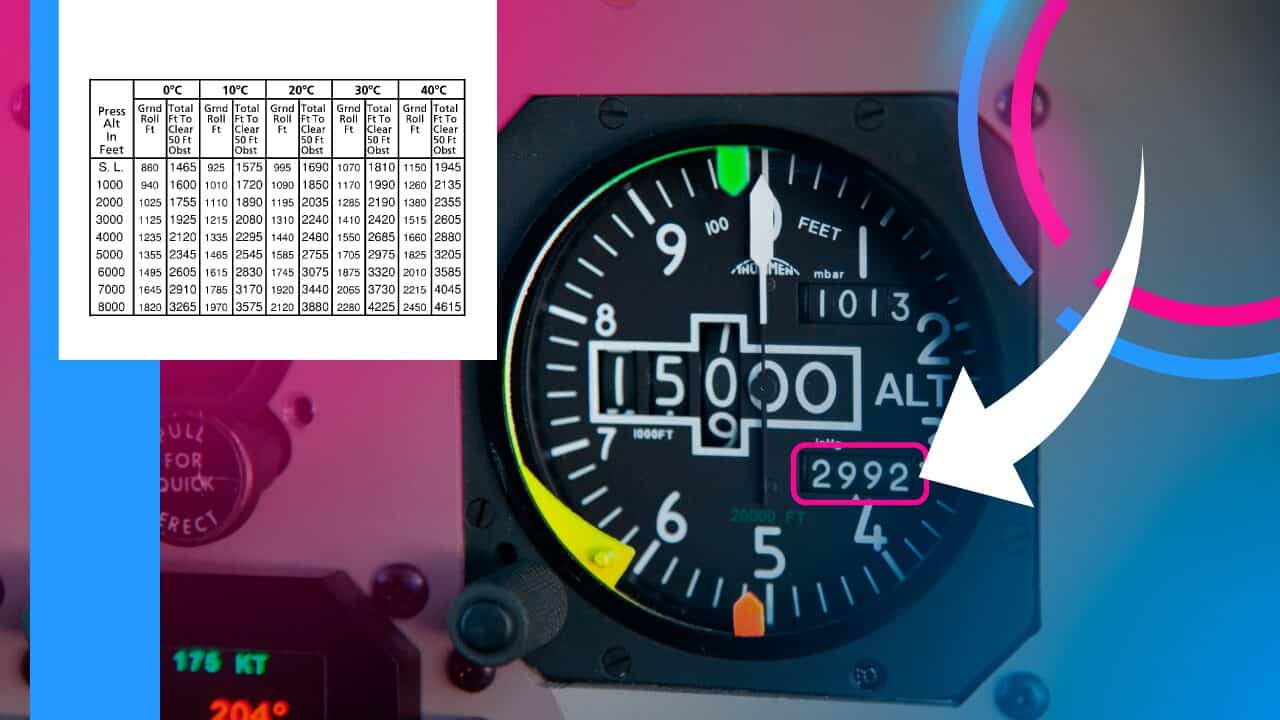The concept of “altitude” isn’t always as straightforward as it seems.
One of the most critical types of altitude is pressure altitude.
Considering the severe consequences of getting it wrong, understanding pressure altitude is critical to your flight’s safety.
In this article, we’ll explain what pressure altitude is, how to calculate and use it, and how it fits in with the other types of altitude, like density altitude.
Ready to become a safer pilot?
Key Takeaways
- Practically speaking, pressure altitude is the altitude you read on your altimeter when it is set to 29.92 inHg.
- True altitude, density altitude, and pressure altitude are the same when standard atmospheric conditions exist (ISA).
- There are three primary ways of determining pressure altitude: The altimeter, the pressure altitude formula, and a flight computer.
- Pressure altitude is a key part of multiple calculations and procedures, allowing everyone to use a standard reference.
What Is Pressure Altitude?
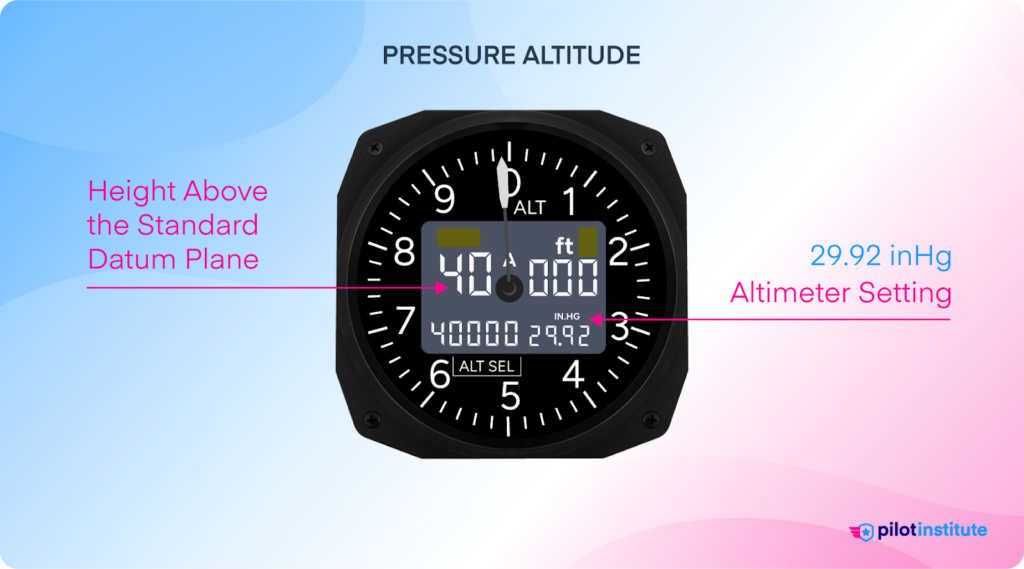
Practically speaking, pressure altitude is the altitude you read on your altimeter when it is set to 29.92 inHg.
More specifically, pressure altitude is the height above a Standard Datum Plane (SDP), which is a theoretical level where the air pressure equals 29.92 inches of mercury (Hg).
In other words, pressure altitude is the height above a standard reference line, which we can measure in the aircraft when we set the altimeter to 29.92 inHg. Think of it as a standard “reference altitude.”
So, why do we use this reference altitude?
Practical Application
There are many reasons why pressure altitude is useful.
One of the most important is that pressure altitude is used as the “baseline” for many other types of altitude, such as density altitude (we’ll discuss the differences between them later).
Pressure altitude is also used above 18,000 ft in the US and Canada to ensure that all aircraft fly according to the same reference. In other words, above 18,000 ft, everyone has 29.92 set on their altimeter.
We’ll look at practical examples of how to use pressure altitude later in this article.
Pressure Altitude vs. True Altitude
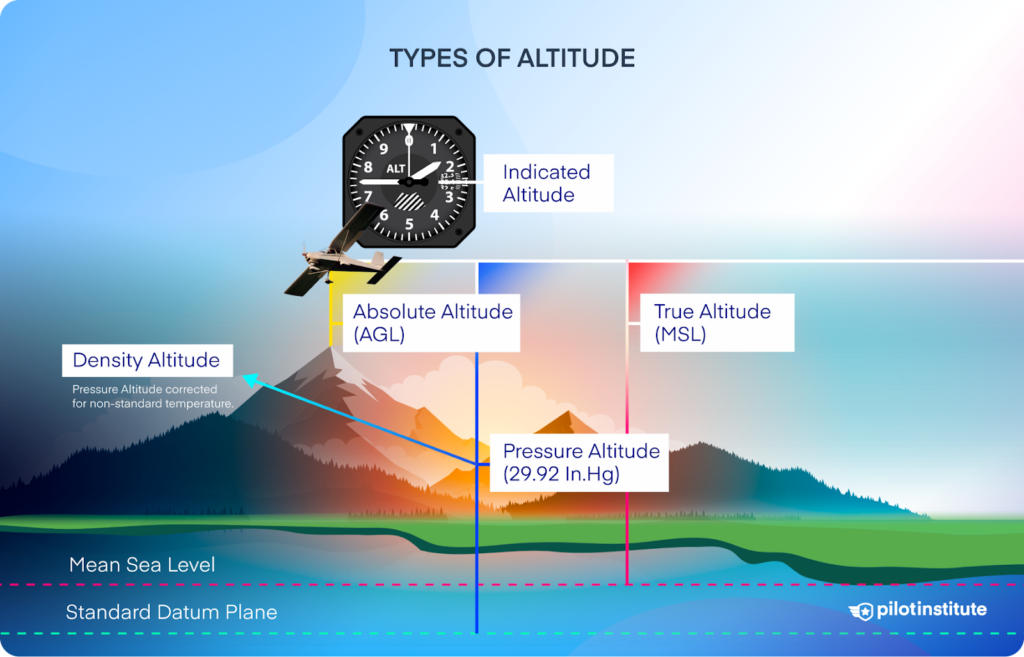
If pressure altitude is used as a reference altitude, how does true altitude fit into the picture?
As a refresher, true altitude is the altitude of the aircraft above Mean Sea Level (MSL).
In other words, true altitude is the altitude you read on your altimeter when you use the specific altimeter setting for a particular location. If you stay below 18,000 ft, it’s the altitude you use during the entire flight.
So, when is true altitude and pressure altitude the same?
When standard atmospheric conditions exist.
Remember the Standard Datum Plane (SDP)? It’s the theoretical reference line for pressure altitude.
The SDP is part of a hypothetical model of the atmosphere known as the International Standard Atmosphere (ISA). Think of the ISA as a snapshot of a fictional day with specific temperatures and pressures, among other measurements.
The altimeter is calibrated according to the ISA day.
Therefore, on this fictional ISA day, our altimeter setting for true altitude is 29.92, and the reference line (SDP) matches Mean Sea Level (MSL).
Remember, the altimeter setting for pressure altitude is also 29.92. Therefore, on this ISA day, the altimeter setting for true altitude and pressure altitude are the same, and the altitudes match.
As soon as conditions begin to deviate from the ISA day, we need to adjust the altimeter setting away from 29.92 to read true altitude.
Now, on a non-standard (i.e., non-ISA) day, our altimeter setting for true altitude is no longer the same as pressure altitude (29.92) – and the altitudes no longer match.
Pressure Altitude vs. Density Altitude
You may be more familiar with the concept of density altitude. If you aren’t familiar or would like a refresher, read our guide on calculating density altitude.
In short, density altitude is pressure altitude corrected for non-standard temperature.
Density altitude is the “effective pressure altitude” the aircraft “feels” for a given temperature. The higher the temperature, the higher the density altitude, and the worse the aircraft performs.
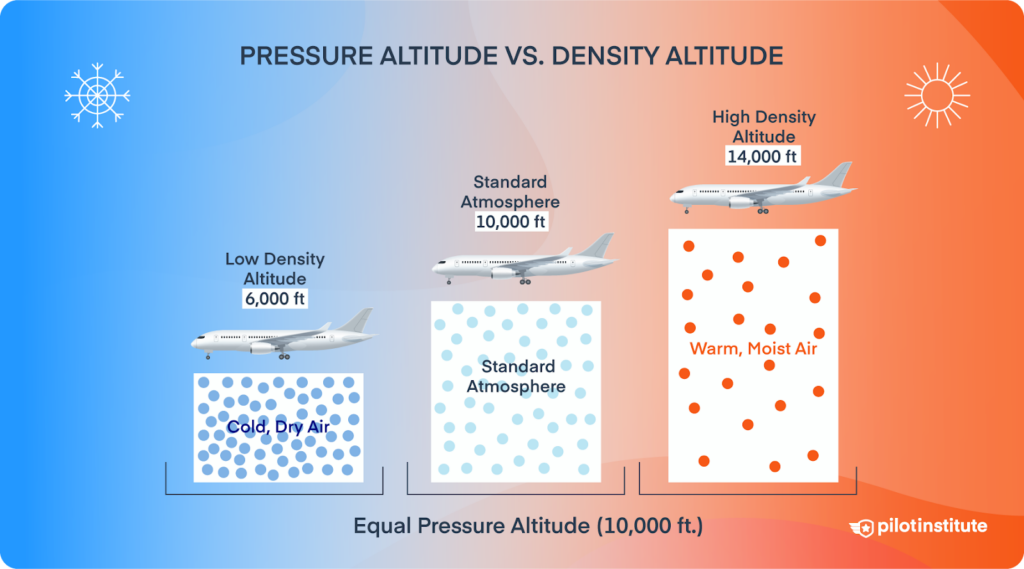
So, when is pressure altitude and density altitude the same?
Just like true altitude, when standard atmospheric conditions exist.
Let’s explain.
Pressure altitude is the starting point for density altitude calculations. Any deviation from the standard atmosphere, and the density altitude will be different from the pressure altitude.
If the temperature is higher than the standard atmosphere (ISA), the density altitude will be higher, and the aircraft will “feel” as if it is flying at a higher pressure altitude.
Checking the density altitude before flight is essential for safety, particularly in hot weather or at high elevations. We discuss these concepts in detail in our Private Pilot Made Easy course.
How to Calculate Pressure Altitude
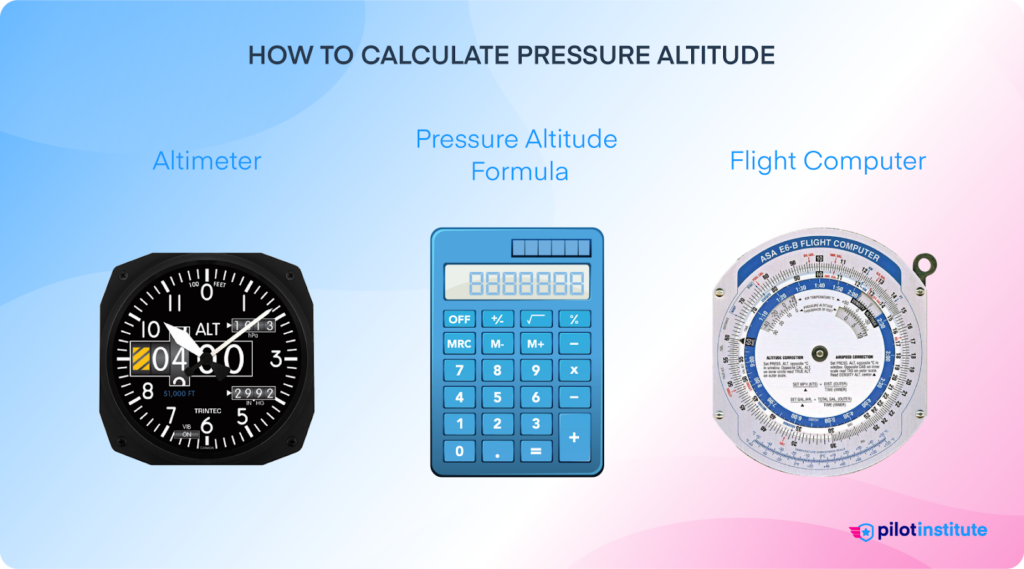
Okay, now that we know what pressure altitude is, how do we calculate it?
There are three primary ways of determining pressure altitude:
- The altimeter.
- The pressure altitude formula.
- A flight computer (CX3, E6B).
The Altimeter
The easiest way to determine pressure altitude is to set 29.92 on the altimeter and read it. This method doesn’t require any math, but what about when you’re outside of the cockpit?
In that case, we can use the pressure altitude formula or a flight computer.
The Pressure Altitude Formula
There are two pressure altitude formulas you should be aware of, the detailed formula (precise but complicated) and the rule of thumb formula (accurate enough and easy).
Let’s cover the rule of thumb formula first, as you’ll likely use it in the wild.
Rule of Thumb Pressure Altitude Formula (Most Practical)
The rule of thumb formula for pressure altitude is:
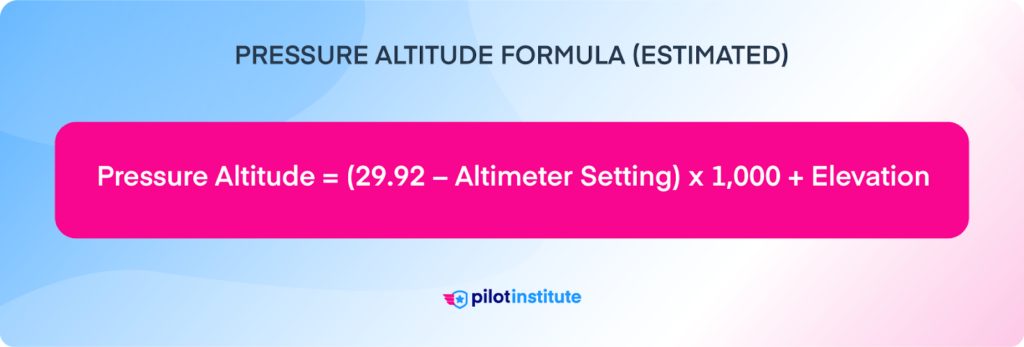
Let’s break it down:
- (29.92 – Altimeter Setting): This section calculates the difference between the standard pressure (29.92 inHg) and current pressure (current altimeter setting), expressed in inches of mercury (inHg).
- x 1,000: By multiplying by 1,000, we convert the pressure difference into feet (1 inHg = 1,000 ft roughly)
- + Elevation: By adding elevation, we account for the actual altitude above Mean Sea Level. If you’re not at an airport, you can simply add your true altitude instead.
Let’s walk through a quick example.
Imagine you’re at an airport with an elevation of 1,500 ft, and the current altimeter setting is 29.42 inHg:
Pressure Altitude = (29.92 − Altimeter Setting) x 1,000 + Elevation
- Pressure Altitude = (29.92 – 29.42) x 1,000 + 1,500
- Pressure Altitude = (0.50) x 1,000 + 1,500
- Pressure Altitude = 500 + 1,500
- Pressure Altitude = 2,000 feet
Voila! Your pressure altitude, in this case, is 2,000 feet.
This formula is great for calculating pressure altitude quickly and accurately enough, but if you want exact numbers, you’ll have to use a more detailed formula.
Detailed Pressure Altitude Formula (Most Accurate)
The most accurate formula for pressure altitude is:
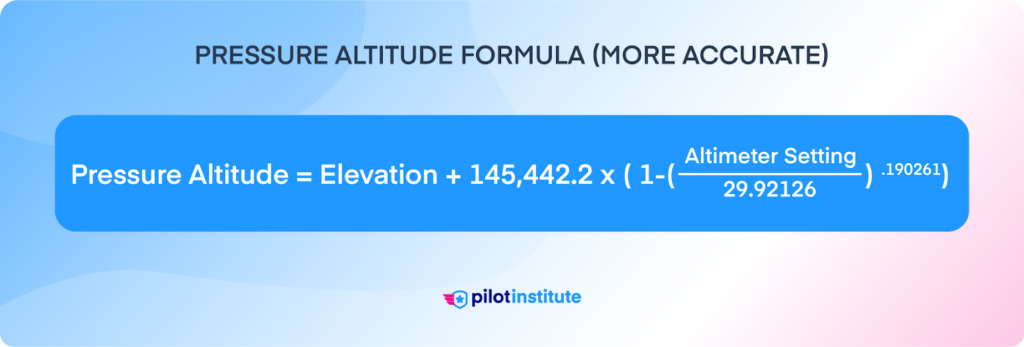
Let’s use the example from earlier and calculate pressure altitude using this formula.
Elevation 1,500 ft, current altimeter setting 29.42 inHg:
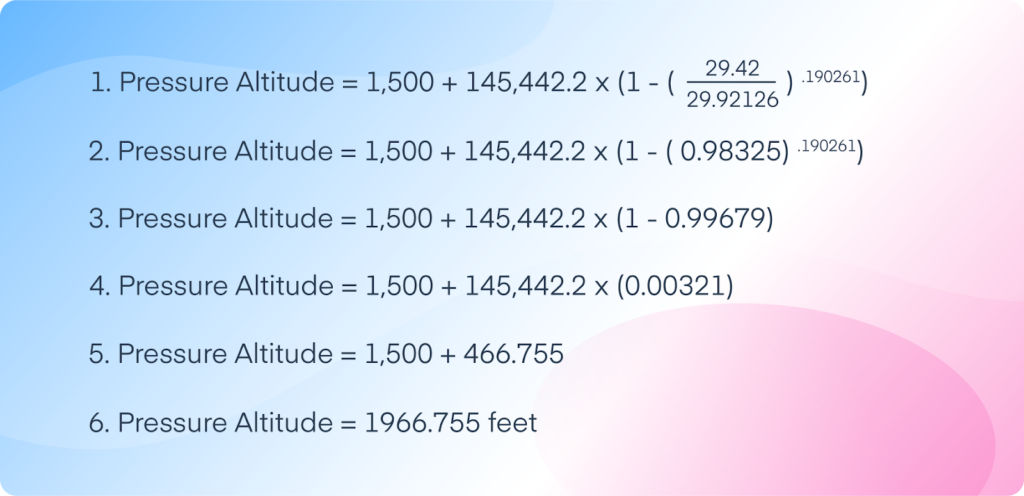
Compared to this answer (we’ll round up to 1,967 ft), the rule of thumb answer was only 33 feet off. Not bad, but if you want to be as accurate as possible, you now know how.
But what if we could simply make a computer do the math?
A Flight Computer (CX3, E6B)
Arguably the easiest and most accurate way to calculate pressure altitude is by using a flight computer, such as ASA’s CX3, Sporty’s Electronic E6B, or an equivalent app.
Let’s look at how to use each.
How to Calculate Pressure Altitude Using a CX3
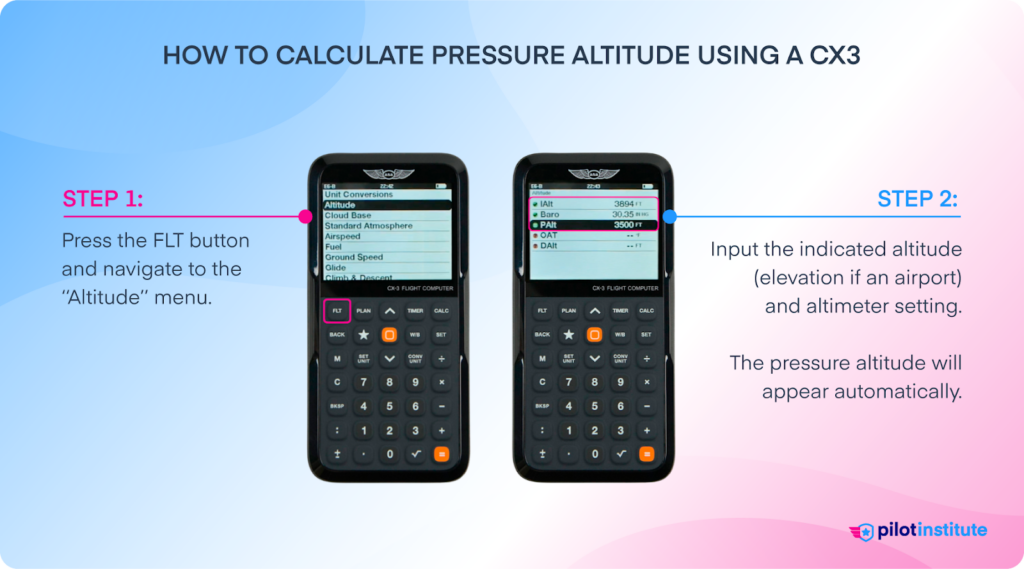
Calculating pressure altitude using ASA’s CX3 is as easy as two steps:
- Press the FLT button and navigate to the “Altitude” menu.
- Input the indicated altitude (elevation if at an airport) and altimeter setting.
The pressure altitude will appear automatically.
How to Calculate Pressure Altitude Using Sporty’s E6B
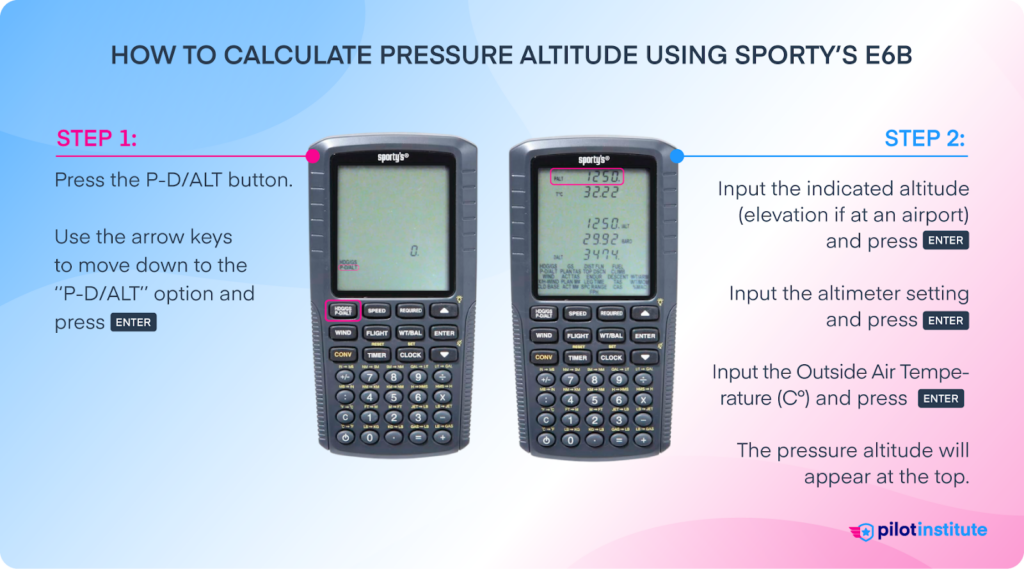
To calculate pressure altitude on Sporty’s E6B:
- Press the P-D/ALT button.
- Use the arrow keys to move down to the “P-D/ALT” option and press enter.
- Input the indicated altitude (elevation if at an airport) and press enter.
- Input the altimeter setting and press enter.
- Input the Outside Air Temperature (in degrees Celsius) and press enter.
The pressure altitude will appear at the top, along with the density altitude at the bottom.
How to Calculate Pressure Altitude Using Sporty’s E6B App
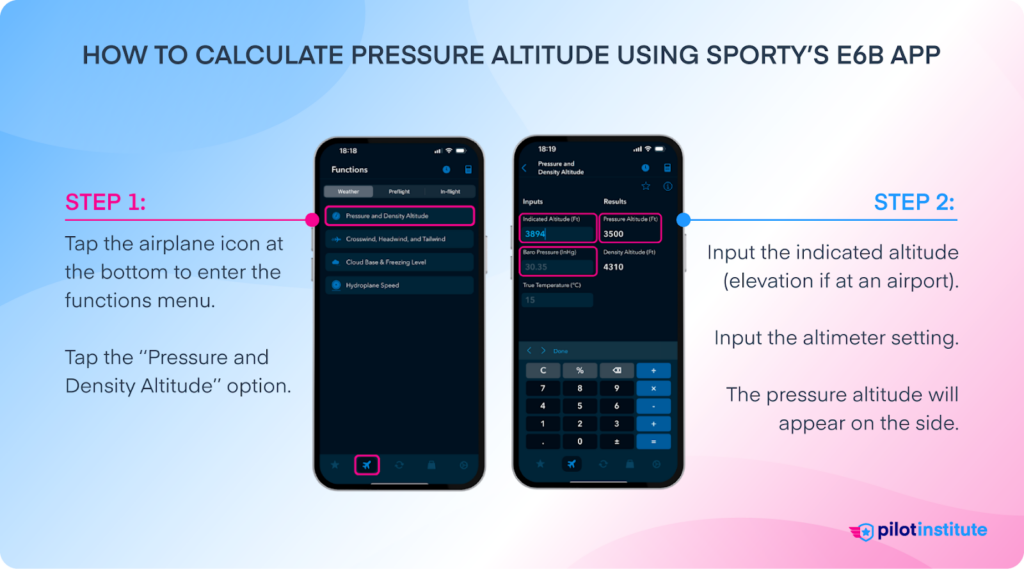
My personal favorite way of calculating pressure altitude is using Sporty’s E6B app.
To calculate pressure altitude on Sporty’s E6B app:
- Tap the airplane icon at the bottom to enter the functions menu.
- Tap the “Pressure and Density Altitude” option.
- Input the indicated altitude (elevation if at an airport).
- Input the altimeter setting.
The pressure altitude will appear on the side.
How to Use Pressure Altitude
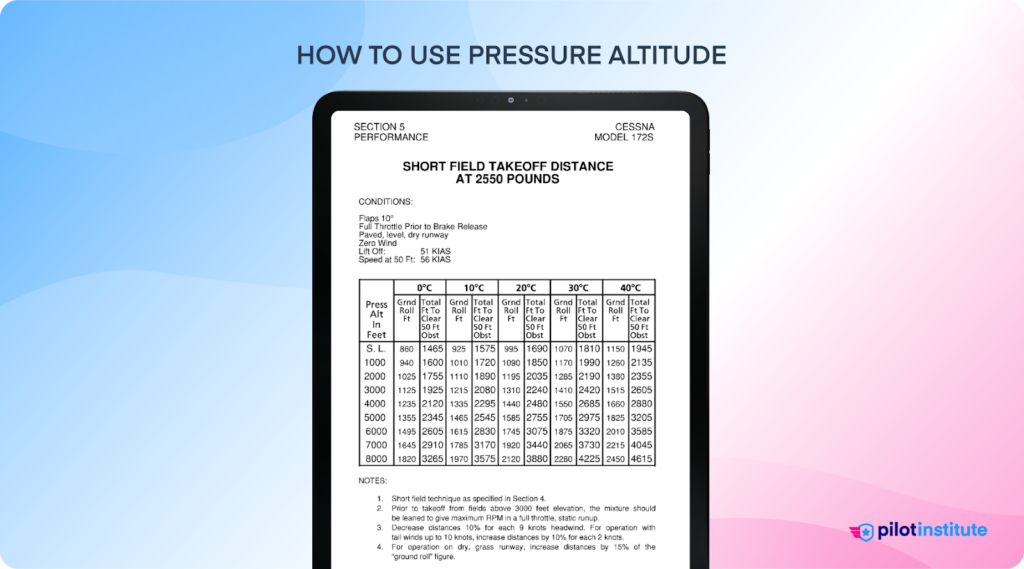
You now know what pressure altitude is and how to calculate it.
But how do you use it?
Let’s look at how pressure altitude is used in everyday flight scenarios.
Flight Planning and Aircraft Performance Charts
Pressure altitude is used in a number of different flight planning scenarios. Pressure altitude often serves as the baseline for other calculations, such as density altitude.
For example, in this short field takeoff distance chart, you only need pressure altitude and temperature to find the takeoff distance:

That’s because the chart automatically calculates density altitude using the pressure altitude and temperature.
Above 18,000 Ft
As mentioned earlier, pilots are required to set their altimeters to the standard 29.92 inches of mercury above 18,000 feet.
This means that all aircraft in Class A airspace use the same altitude reference, reducing the chances of traffic conflicts.
Below 18,000 feet, aircraft switch back to local altimeter settings.
Transponder Altitude Reporting
Your aircraft’s Mode C transponder transmits pressure altitude data, regardless of your actual altimeter setting.
In the tower, pressure altitude is converted to true altitude using the actual altimeter setting.
This means that ATC doesn’t know what altimeter setting you have set in the cockpit, only what altitude you are flying according to their (correct) altimeter setting.
Final Thoughts
Pressure altitude is fundamental to aviation. It is a key part of multiple calculations and procedures, allowing everyone to use a standard reference.
Yet, it’s often misunderstood, even by experienced pilots, who believe it’s only an altimeter setting.
After reading this article, you understand that it is integral to our daily operations as pilots.
With a solid understanding of this “baseline” altitude, learning other performance calculations and altitudes becomes far easier!
